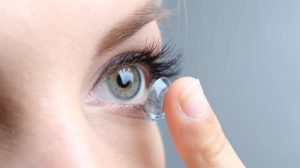In this article, we will learn more about diabetic retinopathy – a common complication among diabetic people – including causes, symptoms, diagnosis and treatments.

What Is Diabetic Retinopathy?
Diabetic retinopathy is an eye condition that develops as a complication in people with diabetes.
The condition is known to progressively damage the blood vessels of the retina. The walls begin to weaken and the blood vessels start leaking blood and fluid into the retina.
Without prompt intervention, diabetic retinopathy can cause permanent vision loss even though it has little to no symptoms in the early stages.
Causes
At first glance, most people think that diabetes and eye health are not related. However, high or fluctuating blood glucose levels caused by diabetes can obstruct the blood supply to the retina, because of damage to the small blood vessels.
Obstructed blood supply results in oxygen deprivation of the retina, which in turn triggers the formation of new, abnormal blood vessels. These new blood vessels are of bad quality and leak easily.
Both type 1 and 2 type diabetes, as well as gestational diabetes (diabetes during pregnancy), have a risk of developing DRP. The risk increases as a result of:
- Prolonged diabetes
- Poor management of blood sugar level
- High cholesterol
- High blood pressure (hypertension)
- Unhealthy lifestyle (smoking, substance use, drinking)
- Pregnancy
- Being Native American, Black, or Hispanic
Stages of Diabetic Retinopathy
Diabetic retinopathy is classified into two main stages: non-proliferative and proliferative diabetic retinopathy.
Non-Proliferative Diabetic Retinopathy (NPDR)
Non-proliferative diabetic retinopathy is the early stage of diabetic retinopathy.
Most people with diabetes type 1 and 60% of people with type 2 have NPDR but are usually unaware because the symptoms are relatively mild.
With NPDR, the blood vessels become tortuous and can start to leak, the retina swells up due to excess fluid. Sometimes the fluid builds up in the central area of the retina causing macular edema. This is the leading cause of blurred vision in people with diabetes.
Proliferative Diabetic Retinopathy (PDR)
Proliferative diabetic retinopathy is an advanced and more severe stage of diabetes-related eye disease. It occurs especially if no action is taken to manage NPDR. The blood vessels close off, cutting off the blood supply to the retina. This triggers the growth of new, abnormal blood vessels which leak blood and fluid into the vitreous, leading to eye floaters or vitreous hemorrhage.
The formation of scar tissue can lead to retina detachment or glaucoma.
Symptoms

As mentioned above, not many people with diabetes realize they have diabetic retinopathy.
However, when it worsens, they may notice the following symptoms:
- Blurry vision
- More presence of floaters
- Fluctuating vision – from blurry to clear and vice versa
- Have problems seeing things at night
- Dark areas in your vision
- Vision loss
Diagnosis
To diagnose DRP your eye doctor will, besides taking a medical history, perform a comprehensive eye exam using drops to dilate the pupil and look at the retina.
Optical coherence tomography (OCT), a non-invasive imaging test, allows one to visualize cross-sections of the retina.
Treatments
Different treatments are available for diabetic retinopathy depending on specific problems and include:
- Medicines: Anti-VEGF injections into the eye stop the growth of new blood vessels.
- Laser treatment: This minimally invasive treatment seals or destroys leaking blood vessels in the retina.
- Vitrectomy: Vitrectomy is a surgical procedure used for complications of proliferative diabetic retinopathy like retina detachment, non-clearing vitreous hemorrhage or macular traction.
Diabetes does not have to lead to vision loss. Diabetes management and yearly eye exams by a specialized ophthalmologist are the most important tools for preventing complications of diabetic retinopathy and preserving vision.
If you have diabetes and want to take control of your eye health, get an eye exam today at EEC.
Every patient deserves top-quality eye care from us. European Eye Center focuses on providing Western-standard services and determining appropriate treatment plans to help patients restore their vision in a feel-like-home atmosphere.
We are happy to help if you have questions about diabetic retinopathy. Don’t hesitate to connect with us at info@europeaneyecenter.com.
Contact us today to schedule an eye care service!







